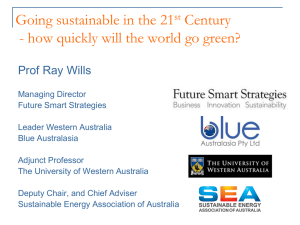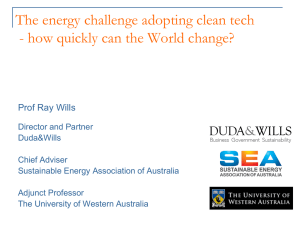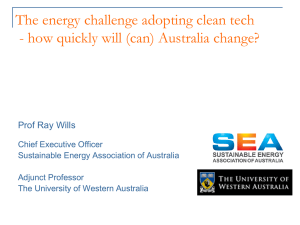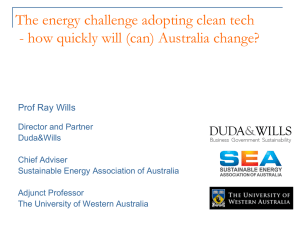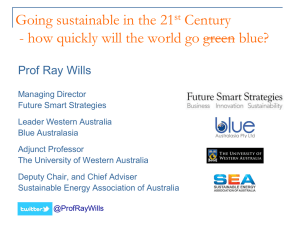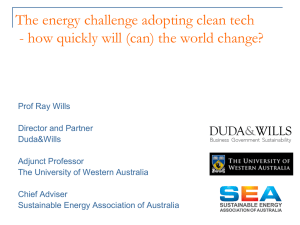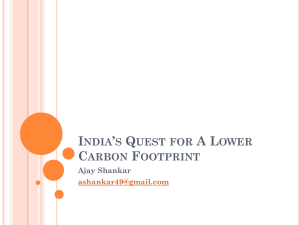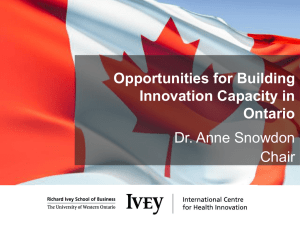Wills-adoptingcleantech-Eilat
advertisement
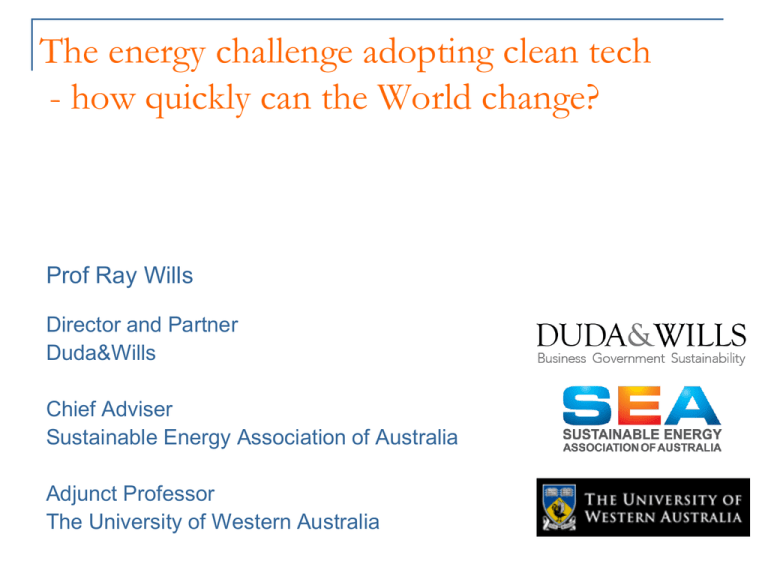
The energy challenge adopting clean tech - how quickly can the World change? Prof Ray Wills Director and Partner Duda&Wills Chief Adviser Sustainable Energy Association of Australia Adjunct Professor The University of Western Australia Adoption of technology The natural turnover and retirement of appliances, buildings and vehicles can bring about a modest penetration of sustainable energy in the next ten years. However, adoption of new technology is often not just ‘natural’ The transition to sustainable energy, like many new technology shifts, will be more rapid with changes favoured by: policy measures and regulation; consumer sentiment; pricing advantage. Roger’s diffusion curve Technology adoption rates – US Will electric cars be dishwashers or VCRs? NY Times Technology adoption rates - vehicles Zoepf 2011 Technology adoption rates - vehicles Zoepf 2011 Technology adoption - manufacturers Zoepf 2011 Technology adoption rates Can historic deployment rates be used to describe future technologies? Expect some similarities – just faster! Small-scale deployment for approximately five years - exponential growth and an inflection point ten or more years after first application Is there an opportunity for disruptive technology entry? Beginnings of disruptive innovation may be in market innovations, Vehicle ownership model (eg Better Place) could rapidly change the how and what is purchased Roof top solar – companies may own the panels on your roof Technology adoption rates www.kickstarter.com Technology adoption rates Marked decrease in developmental lag Innovation/development of new products Supply side capabilities Market competition Growing consumer expectations Higher level of communication between consumers - blogspace Fleet/building/operations managers – and CFOs Regulation Energy security Renewable energy growth Data IEA Global renewables 2013? Data UNEP Global electricity … IEA Energy Statistics Statistics on the Web: http://www.iea.org/stats/index.asp Electricity generation by fuel World 25 000 000 20 000 000 GWh 15 000 000 10 000 000 5 000 000 0 1971 1973 1975 1977 1979 1981 1983 1985 1987 1989 1991 1993 1995 1997 1999 2001 2003 2005 2007 2009 Coal/peat © OECD/IEA 2011 Oil Natural gas Nuclear Hydro Biofuels & waste Geothermal/solar/wind For more detailed data, please consult our on-line data service at http://data.iea.org. Trends in car prices and CO2 2002-2010 How clean are Europe’s cars? Global electricity growth - Europe Australian renewables 2011… The transformation of Australia’s energy mix has begun – in 2011 new electricity generation construction 25% solar, 31% gas and 33% wind. Coal-fired power currently 75% of Australia’s total generation - in 2011 only 14% of new investment was coal. This is still behind the average world-wide investment in renewable energy – China’s economy 8 times larger than Australia, investment in renewables over 20 times larger! Australian electricity consumption 2012… Solar on Australian homes Technology energy use www.epri.com Global electricity growth www.seaaus.com.au

